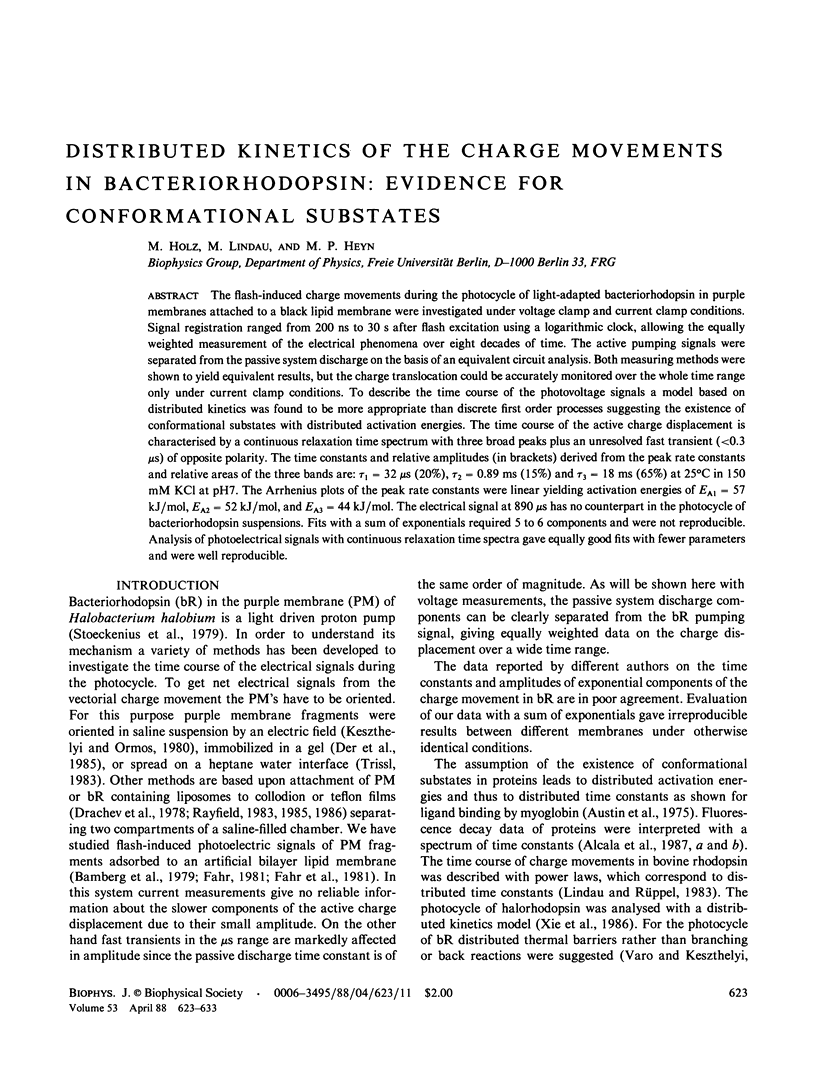Abstract
The flash-induced charge movements during the photocycle of light-adapted bacteriorhodopsin in purple membranes attached to a black lipid membrane were investigated under voltage clamp and current clamp conditions. Signal registration ranged from 200 ns to 30 s after flash excitation using a logarithmic clock, allowing the equally weighted measurement of the electrical phenomena over eight decades of time. The active pumping signals were separated from the passive system discharge on the basis of an equivalent circuit analysis. Both measuring methods were shown to yield equivalent results, but the charge translocation could be accurately monitored over the whole time range only under current clamp conditions. To describe the time course of the photovoltage signals a model based on distributed kinetics was found to be more appropriate than discrete first order processes suggesting the existence of conformational substates with distributed activation energies. The time course of the active charge displacement is characterised by a continuous relaxation time spectrum with three broad peaks plus an unresolved fast transient (<0.3 μs) of opposite polarity. The time constants and relative amplitudes (in brackets) derived from the peak rate constants and relative areas of the three bands are: τ1 = 32 μs (20%), τ2 = 0.89 ms (15%) and τ3 = 18 ms (65%) at 25°C in 150 mM KCl at pH7. The Arrhenius plots of the peak rate constants were linear yielding activation energies of EA1 = 57 kJ/mol, EA2 = 52 kJ/mol, and EA3 = 44 kJ/mol. The electrical signal at 890 μs has no counterpart in the photocycle of bacteriorhodopsin suspensions. Fits with a sum of exponentials required 5 to 6 components and were not reproducible. Analysis of photoelectrical signals with continuous relaxation time spectra gave equally good fits with fewer parameters and were well reproducible.
Full text
PDF










Selected References
These references are in PubMed. This may not be the complete list of references from this article.
- Alcala J. R., Gratton E., Prendergast F. G. Fluorescence lifetime distributions in proteins. Biophys J. 1987 Apr;51(4):597–604. doi: 10.1016/S0006-3495(87)83384-2. [DOI] [PMC free article] [PubMed] [Google Scholar]
- Alcala J. R., Gratton E., Prendergast F. G. Interpretation of fluorescence decays in proteins using continuous lifetime distributions. Biophys J. 1987 Jun;51(6):925–936. doi: 10.1016/S0006-3495(87)83420-3. [DOI] [PMC free article] [PubMed] [Google Scholar]
- Austin R. H., Beeson K. W., Eisenstein L., Frauenfelder H., Gunsalus I. C. Dynamics of ligand binding to myoglobin. Biochemistry. 1975 Dec 2;14(24):5355–5373. doi: 10.1021/bi00695a021. [DOI] [PubMed] [Google Scholar]
- Doster W. Viscosity scaling and protein dynamics. Biophys Chem. 1983 Mar;17(2):97–103. doi: 10.1016/0301-4622(83)80002-7. [DOI] [PubMed] [Google Scholar]
- Drachev L. A., Kaulen A. D., Khitrina L. V., Skulachev V. P. Fast stages of photoelectric processes in biological membranes. I. Bacteriorhodopsin. Eur J Biochem. 1981 Jul;117(3):461–470. doi: 10.1111/j.1432-1033.1981.tb06361.x. [DOI] [PubMed] [Google Scholar]
- Drachev L. A., Kaulen A. D., Skulachev V. P. Time resolution of the intermediate steps in the bacteriorhodopsin-linked electrogenesis. FEBS Lett. 1978 Mar 1;87(1):161–167. doi: 10.1016/0014-5793(78)80157-4. [DOI] [PubMed] [Google Scholar]
- Dér A., Hargittai P., Simon J. Time-resolved photoelectric and absorption signals from oriented purple membranes immobilized in gel. J Biochem Biophys Methods. 1985 Mar;10(5-6):295–300. doi: 10.1016/0165-022x(85)90063-6. [DOI] [PubMed] [Google Scholar]
- Groma G. I., Dancshazy Z. How Many M Forms are there in the Bacteriorhodopsin Photocycle? Biophys J. 1986 Aug;50(2):357–366. doi: 10.1016/S0006-3495(86)83469-5. [DOI] [PMC free article] [PubMed] [Google Scholar]
- Marrero H., Rothschild K. J. Conformational changes in bacteriorhodopsin studied by infrared attenuated total reflection. Biophys J. 1987 Oct;52(4):629–635. doi: 10.1016/S0006-3495(87)83254-X. [DOI] [PMC free article] [PubMed] [Google Scholar]
- Ort D. R., Parson W. W. Flash-induced volume changes of bacteriorhodopsin-containing membrane fragments and their relationship to proton movements and absorbance transients. J Biol Chem. 1978 Sep 10;253(17):6158–6164. [PubMed] [Google Scholar]
- Parak F., Knapp E. W., Kucheida D. Protein dynamics. Mössbauer spectroscopy on deoxymyoglobin crystals. J Mol Biol. 1982 Oct 15;161(1):177–194. doi: 10.1016/0022-2836(82)90285-6. [DOI] [PubMed] [Google Scholar]
- Provencher S. W. A Fourier method for the analysis of exponential decay curves. Biophys J. 1976 Jan;16(1):27–41. doi: 10.1016/S0006-3495(76)85660-3. [DOI] [PMC free article] [PubMed] [Google Scholar]
- Provencher S. W., Dovi V. G. Direct analysis of continuous relaxation spectra. J Biochem Biophys Methods. 1979 Dec;1(6):313–318. doi: 10.1016/0165-022x(79)90021-6. [DOI] [PubMed] [Google Scholar]
- Rayfield G. W. Events in proton pumping by bacteriorhodopsin. Biophys J. 1983 Feb;41(2):109–117. doi: 10.1016/S0006-3495(83)84413-0. [DOI] [PMC free article] [PubMed] [Google Scholar]
- Rayfield G. W. Evidence that charge motion within bacteriorhodopsin depends on solvent viscosity. Photochem Photobiol. 1986 Feb;43(2):171–174. doi: 10.1111/j.1751-1097.1986.tb09510.x. [DOI] [PubMed] [Google Scholar]
- Rayfield G. W. Temperature dependence of photovoltages generated by bacteriorhodopsin. Biophys J. 1985 Jul;48(1):111–115. doi: 10.1016/S0006-3495(85)83764-4. [DOI] [PMC free article] [PubMed] [Google Scholar]
- Stein D. L. A model of protein conformational substates. Proc Natl Acad Sci U S A. 1985 Jun;82(11):3670–3672. doi: 10.1073/pnas.82.11.3670. [DOI] [PMC free article] [PubMed] [Google Scholar]
- Stoeckenius W., Lozier R. H., Bogomolni R. A. Bacteriorhodopsin and the purple membrane of halobacteria. Biochim Biophys Acta. 1979 Mar 14;505(3-4):215–278. doi: 10.1016/0304-4173(79)90006-5. [DOI] [PubMed] [Google Scholar]
- Váró G., Keszthelyi L. Photoelectric signals from dried oriented purple membranes of Halobacterium halobium. Biophys J. 1983 Jul;43(1):47–51. doi: 10.1016/S0006-3495(83)84322-7. [DOI] [PMC free article] [PubMed] [Google Scholar]


